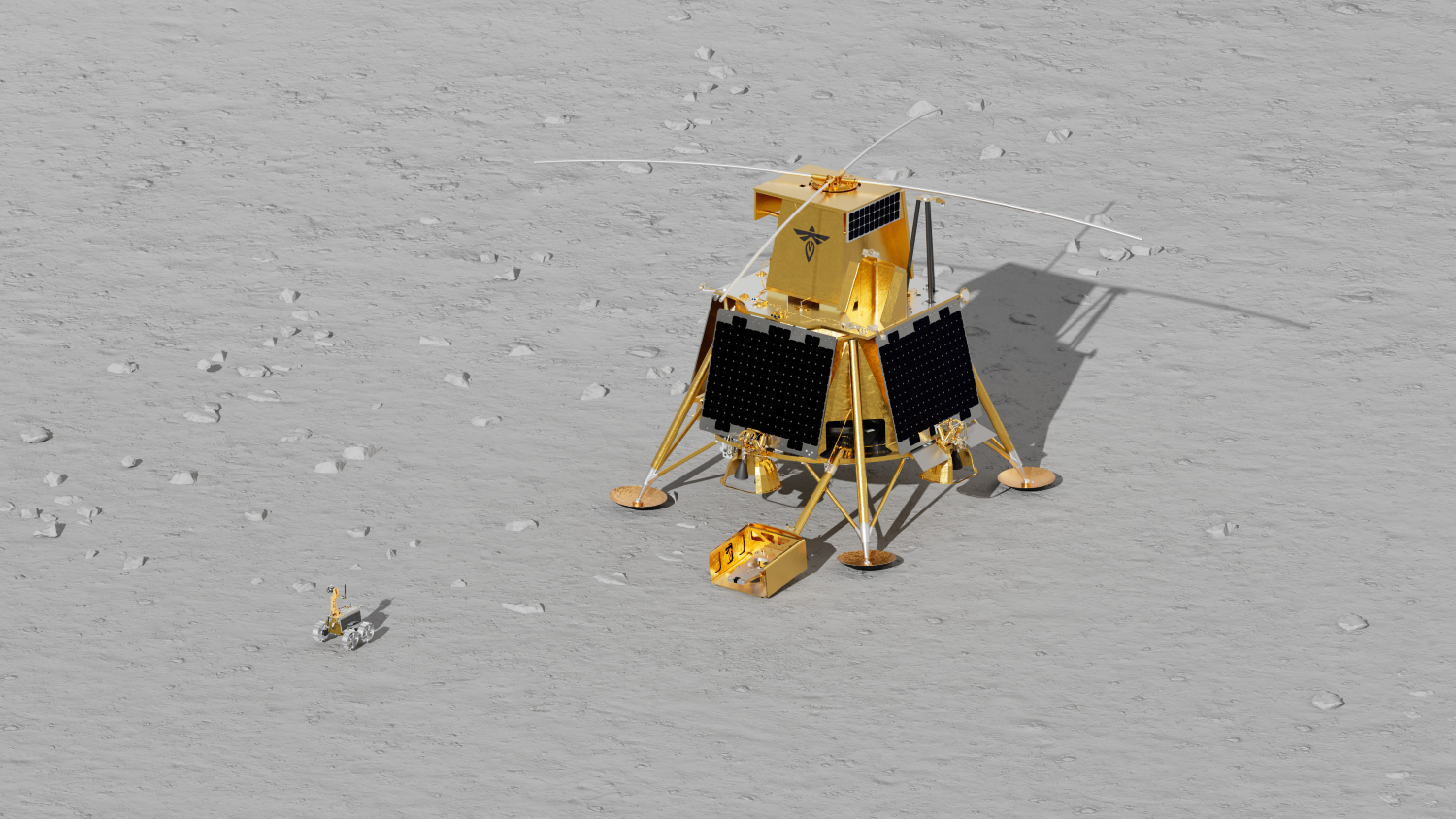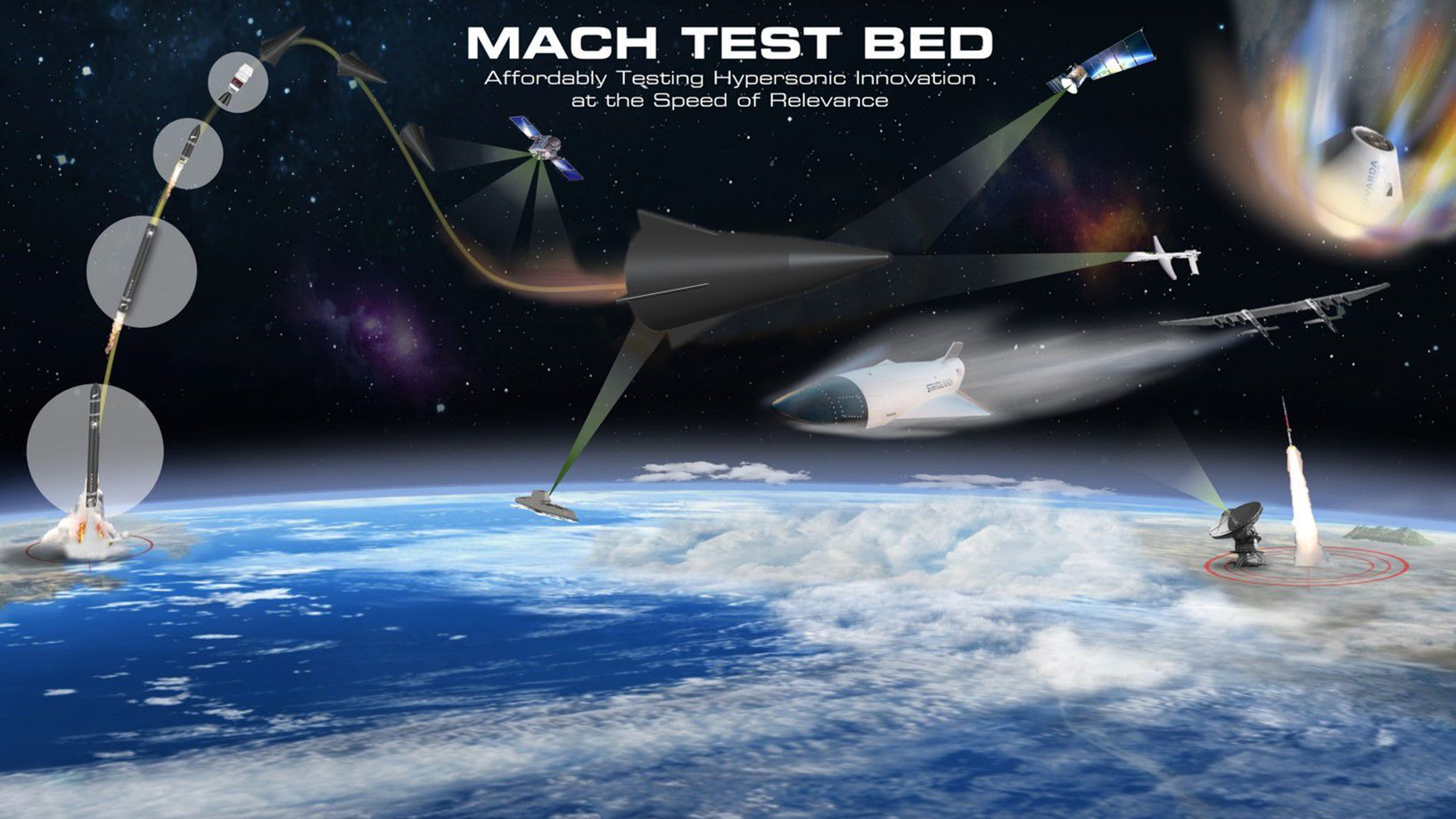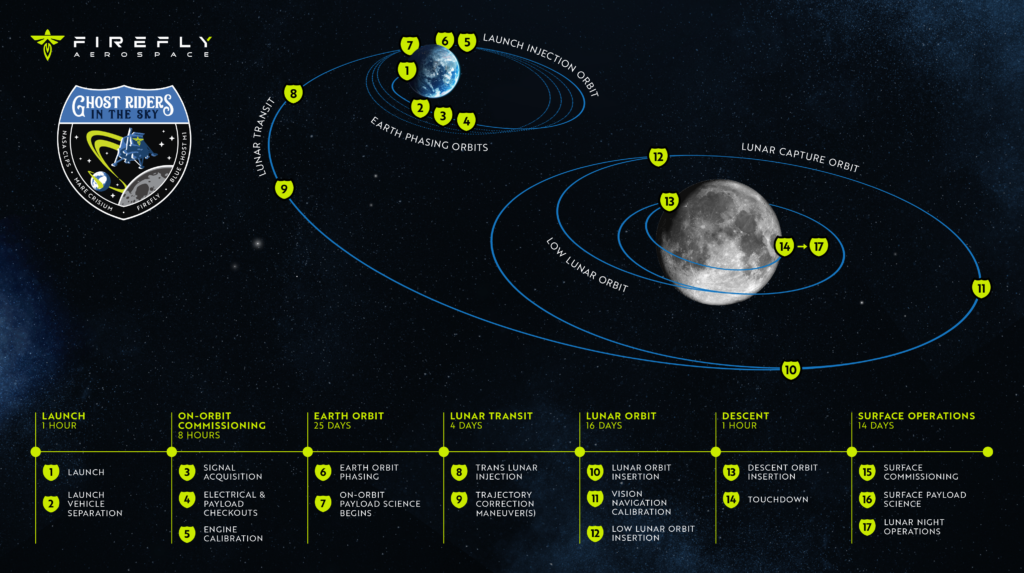
From liftoff to landing, Firefly will provide regular mission updates all along the way to the Moon. Visit Firefly’s Blue Ghost Mission 1 webpage for more mission details and Firefly’s Blue Ghost Mission 1 Flickr album for imagery and b-roll.
SURFACE OPERATIONS
March 18, 2025: Lunar Sunset Imagery
Firefly’s Blue Ghost lander captured the first HD imagery of a lunar sunset from the Moon on March 16. These images, captured by different camera angles and stitched together in a video, show a horizon glow that comes to life just above the Moon’s surface as the sun goes down. Earth and Venus (further in the distance) are also shown above the Moon. Additional sunset imagery can be found in Firefly’s Flickr album. The NASA science team is excited to analyze these images further and share more on the findings soon.
March 17, 2025: Successful Mission Complete
Firefly met 100% of our mission objectives for Blue Ghost Mission 1 after performing the first fully successful commercial Moon landing on March 2, completing more than 14 days of surface operations (346 hours of daylight), and operating just over 5 hours into the lunar night with the final data received around 6:15 pm CDT on March 16. This achievement marks the longest commercial operations on the Moon to date. Read more in Firefly’s press release here: Firefly Aerospace Successfully Completes 14 Days of Surface Operations on the Moon.
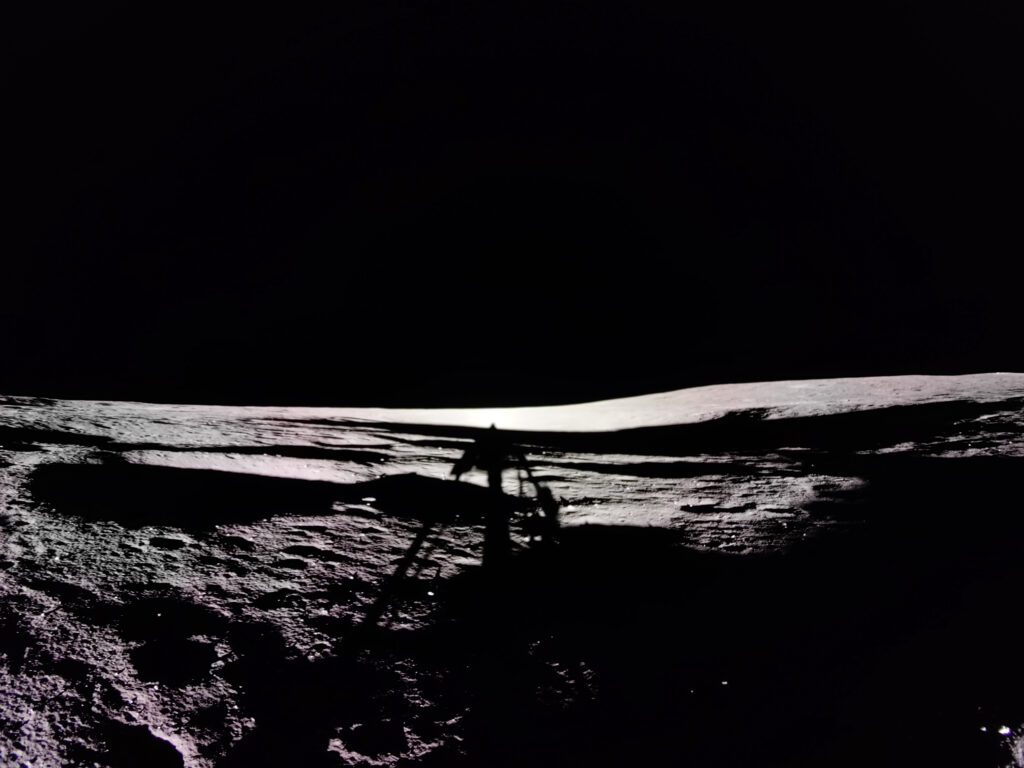
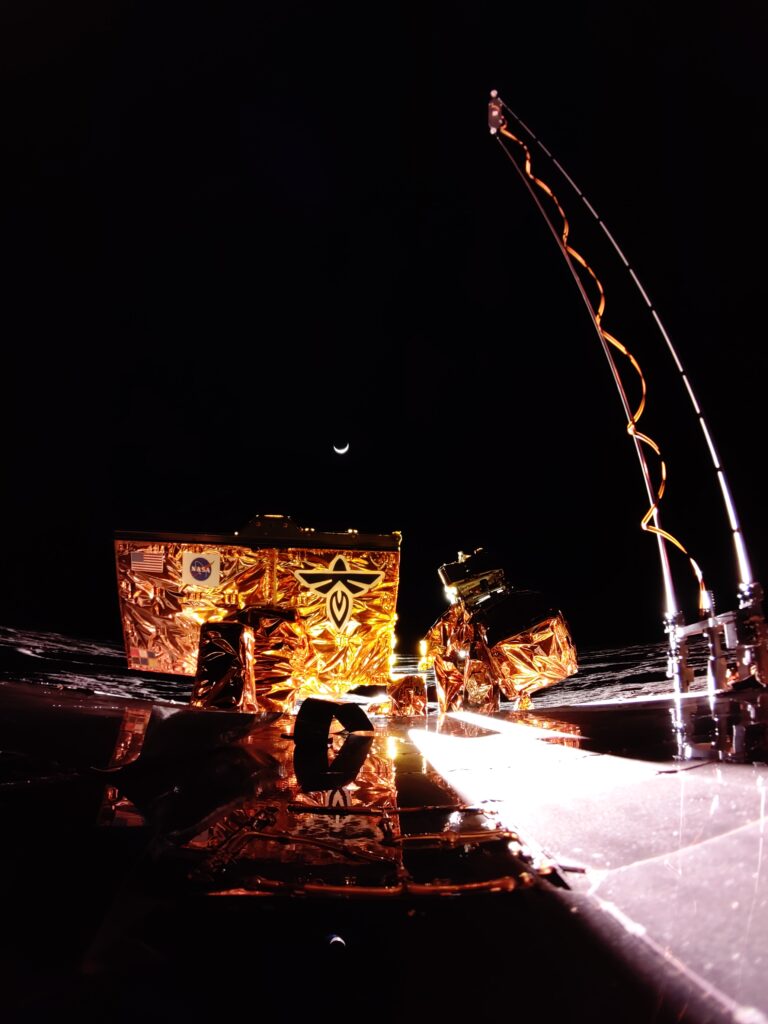
March 16, 2025: Lunar Sunset Operations
The sun is setting on Blue Ghost’s historic mission on the Moon. After two weeks of operations during the lunar day, the Firefly team is preparing for final operations during sunset and into the lunar night. Before we say goodnight, we hope to capture the sunset glow and dust levitation seen by the Apollo 17 astronauts as they were leaving the Moon. More to come soon!
March 14, 2025: Blue Ghost Captures Red Lunar Surface During Eclipse
Blue Ghost turns red! Our lander downlinked more imagery from the Moon captured around 2:30 am CDT during the totality of the solar eclipse. These images – rapidly captured by our top deck camera with different exposure settings – were stitched together in a quick clip. The red hue is the result of sunlight refracting through the Earth’s atmosphere as the sun is blocked by our planet, casting a shadow on the lunar surface. The glowing ring of the eclipse is again seen on Blue Ghost’s solar panel. You can also spot Mercury (left) and Venus (right) just above the eclipse!
March 14, 2025: Total Solar Eclipse Diamond Ring Effect
Blue Ghost got her first diamond ring! Captured at our landing site in the Moon’s Mare Crisium around 3:30 am CDT, the photo shows the sun about to emerge from totality behind Earth. This marks the first time in history a commercial company was actively operating on the Moon and able to observe a total solar eclipse where the Earth blocks the sun and casts a shadow on the lunar surface. This phenomenon occurred simultaneously as the lunar eclipse we witnessed on Earth. We hope to have more shots to share soon!
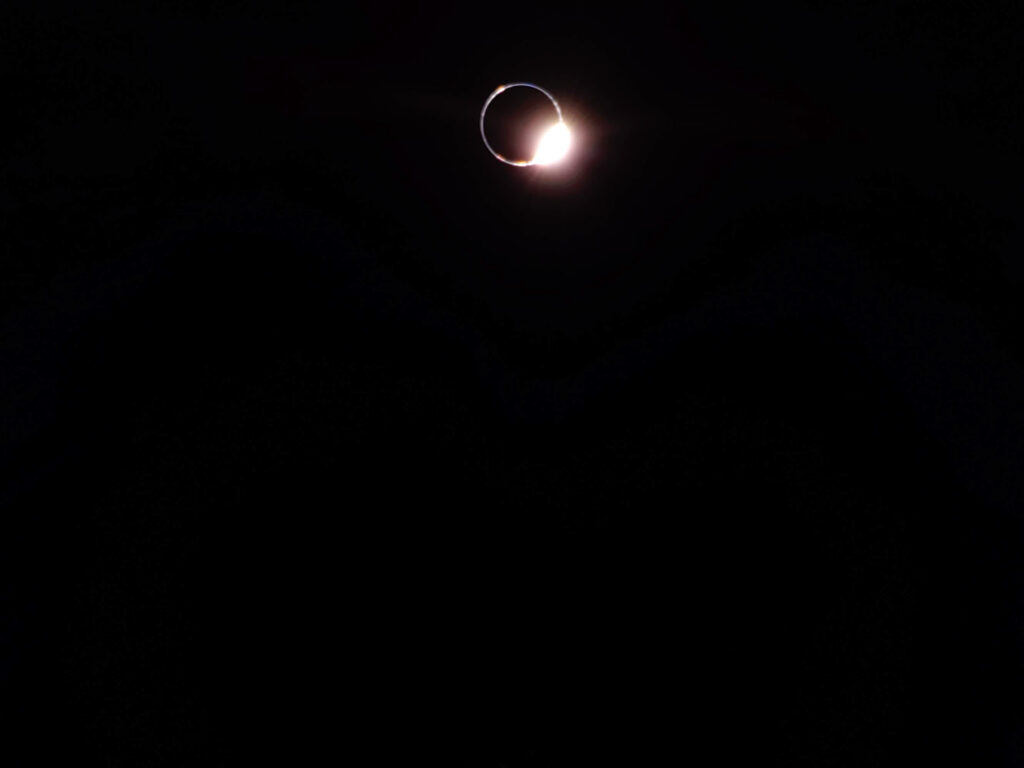
March 14, 2025: First Solar Eclipse Image
Blue Ghost caught her first look at the solar eclipse from the Moon around 12:30 am CDT. Notice the glowing ring of light emerge in the reflection of our solar panel as Earth began to block the sun. This photo taken from the lander’s top deck also shows our X-band antenna (left), the Lunar Environment heliospheric X-ray Imager (center), and the Lunar Magnetotelluric Sounder mast (right). During the eclipse, the surface temperatures dropped from 40°C to -170° C. We hope to downlink more imagery soon once our X-band antenna warms up from the cold temperatures faced in the darkness of totality. Stay tuned!
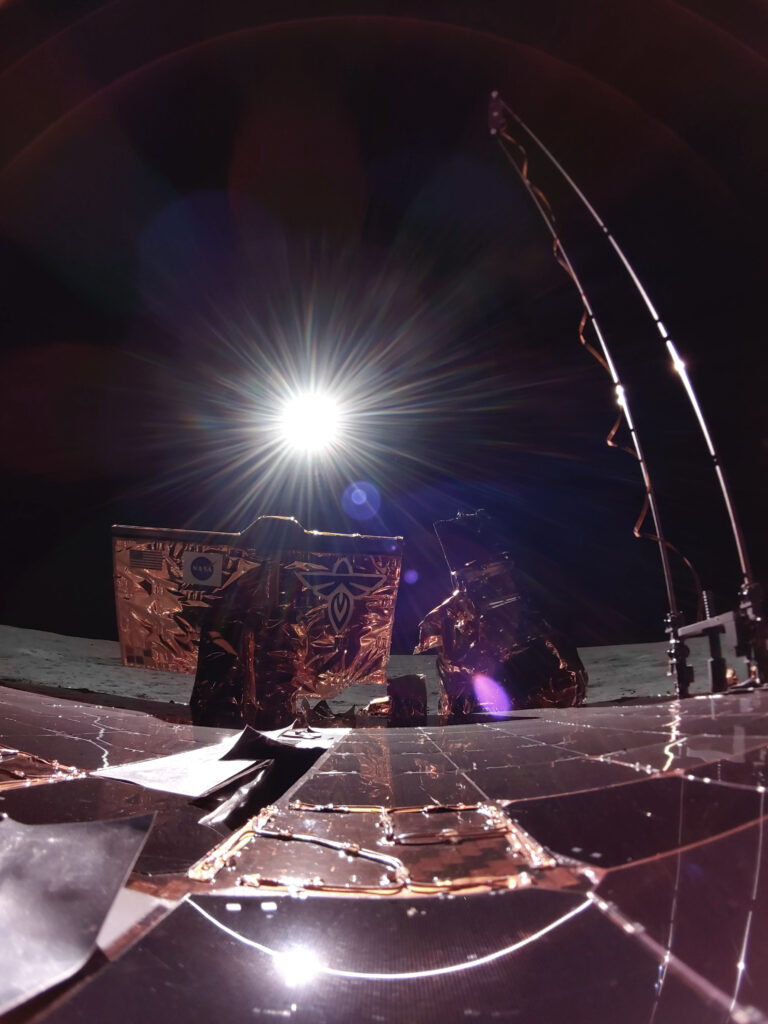
March 13, 2025: Operation Solar Eclipse on the Moon
On March 14, Blue Ghost will witness a rare eclipse from the Moon! This marks the first time in history a commercial company will be actively operating on the Moon and able to observe a total solar eclipse where the Earth blocks the sun and casts a shadow on the lunar surface.
The eclipse will last nearly 5 hours starting at 12 am CST through 4:52 am CST at Firefly’s landing site in Mare Crisium and will include approximately 2 hours and 16 minutes of totality, starting at 1:18 am CST. Although not a mission requirement, Firefly hopes to image the eclipse and potentially operate NASA instruments to measure changes in the lunar environment from our unique vantage point on the Moon.
Back on Earth, we’ll all witness a different phenomenon that happens simultaneously – a lunar eclipse, also known as a Blood Moon, where Earth moves between the sun and the Moon, causing the Moon to be completely shadowed by Earth and appear red.
In contrast, Blue Ghost will witness a glowing ring of sunlight when the Earth blocks the sun above the Moon’s horizon. This ring may also appear red as the sunlight refracts through the Earth’s atmosphere. Firefly aims to capture this with a wide-lens camera on Blue Ghost’s top deck, so the glowing ring will likely appear fairly small in the distance, similar to the size of Earth captured below by Blue Ghost upon landing on the Moon.
Capturing this footage requires Blue Ghost to rely on its batteries for power rather than its solar panels, so it will be a challenge to image during the darkness of the eclipse, but we hope to capture this incredible phenomenon and share it with the world. Stay tuned!

March 13, 2025: SCALPSS Landing Footage
A team at NASA’s Langley Research Center captured first-of-its-kind imagery with the Stereo Cameras for Lunar-Plume Surface Studies (SCALPSS) 1.1 instrument integrated on Firefly’s Blue Ghost lunar lander. The cameras took the images during Blue Ghost’s final descent, showing our engine plumes interacting with the Moon’s surface. This data will help inform future robotic and crewed Moon landings. Learn more about the footage on NASA’s blog here.
March 12, 2025: Ongoing Power Cycling
Blue Ghost remains operational as we continue to wait out the remaining lunar noontime heat with power cycles. We’ve kept our uplink carrier on during this time. With temperatures on the decline, Blue Ghost is staying on longer with each cycle and we expect to start humming with full power again soon! The lander and payloads remain healthy in the meantime.
March 10, 2025: LISTER Drilling Operations
Blue Ghost has performed ongoing LISTER operations over the past week. Mounted below Blue Ghost’s lower deck, NASA’s Lunar Instrumentation for Subsurface Thermal Exploration with Rapidity (LISTER) payload is a pneumatic, gas-powered drill developed by Texas Tech University and Honeybee Robotics that measures the temperature and flow of heat from the Moon’s interior. Video below shows the first LISTER operation on March 3.
March 8, 2025: Planned Power Cycling for Lunar Noon
Day 7 and the Moon is heating up as we approach lunar noon – the hottest part of the lunar day that can get up 250°F (121°C). In preparation, Blue Ghost has begun planned power cycling to keep the lander as cool as possible. With eight payloads’ objectives already complete, we aim to continue operating our two remaining payloads throughout these power cycles. We’ll gradually get back to full power once the surface temperatures start to cool down again. Stay tuned for more!
March 7, 2025: Lunar Magnetotelluric Sounder Deployment Footage
Shortly after landing, Blue Ghost deployed four tethered Lunar Magnetotelluric Sounder (LMS) electrodes to the surface and a more than 6-foot mast above our top deck. Look closely in the video below! These instruments will allow NASA and the Southwest Research Institute to study the deep interior of the Moon – up to two-thirds the distance to the Moon’s center – to learn more about the structure and composition of the Moon’s mantle.
March 6, 2025: Eight Payload Objectives Complete
Just over four days on the Moon’s surface and Blue Ghost is checking off several science milestones! Eight out of 10 NASA payloads, including LPV, EDS, NGLR, RAC, RadPC, LuGRE, LISTER, and SCALPSS, have already met their mission objectives with more to come. Lunar PlanetVac for example successfully collected, transferred, and sorted lunar soil from the Moon using pressurized nitrogen gas.
Video below shows Lunar PlanetVac operations after the payload was deployed on Blue Ghost’s surface access arm. Congrats to the Honeybee Robotics and NASA team on this incredible achievement!
March 4, 2025: Moon Landing Footage Released
Watch Firefly land on the Moon! After identifying surface hazards and selecting a safe landing site, Blue Ghost landed directly over the target in Mare Crisium. The Firefly team has since downlinked our landing footage for the world to see — a historic moment on March 2 we’ll never forget.
March 4, 2025: Ongoing Surface Operations
Just in the last two days, Firefly’s downlinked data increased from 27 GB to 57 GB as Blue Ghost continues NASA payload operations on the lunar surface. Operations include deploying Lunar PlanetVac and sampling lunar regolith, deploying the Electrodynamic Dust Shield and demonstrating dust mitigation, capturing images of lunar regolith from SCALPSS during descent, utilizing LuGRE to track Global Navigation Satellite System (GNSS) signals on the Moon’s surface for the first time ever, and continuing operations for the other payloads. Get more details on the operations on NASA’s blog here.
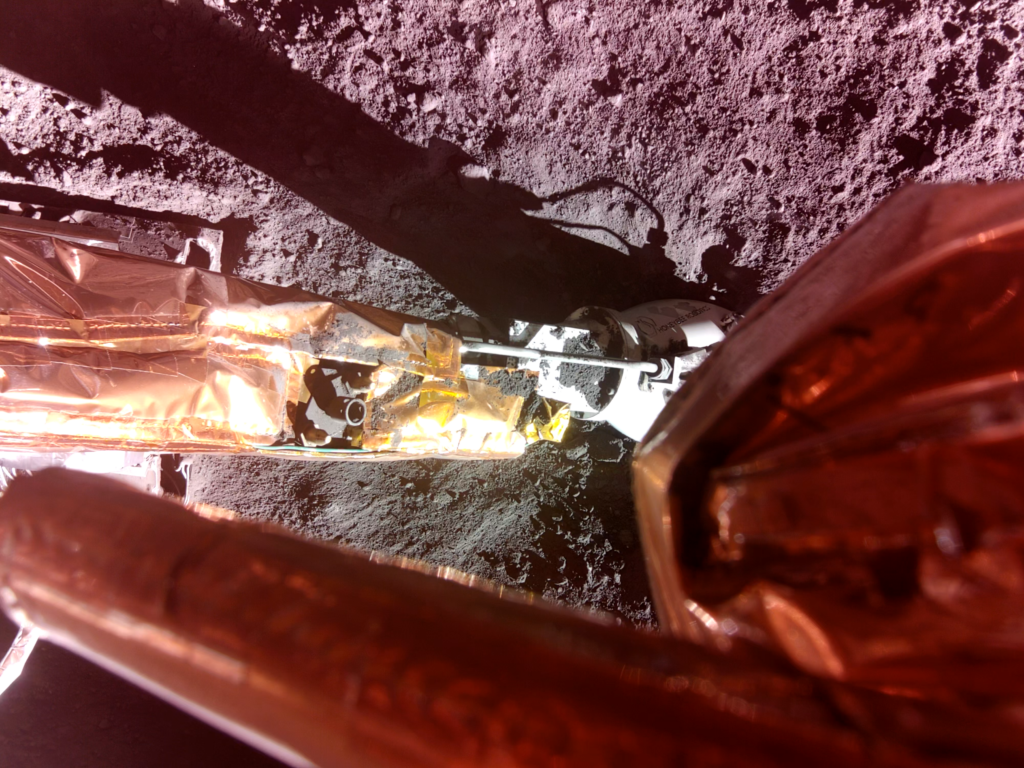
March 2, 2025: X-Band Antenna Deployed
Blue Ghost’s X-band antenna has deployed! This will allow us to more rapidly downlink high-definition imagery and videos and transmit payload science data back to Earth. Stay tuned for more!
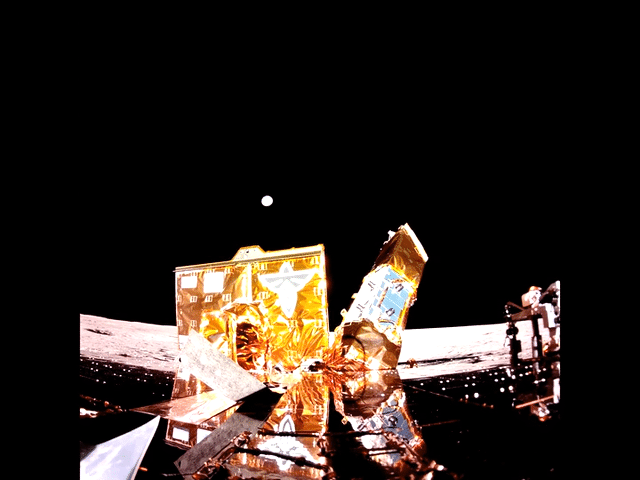
DESCENT OPERATIONS
March 2, 2025, 5:15 am CST: Moon Images with Earth on Horizon
Blue Ghost captured even more incredible images after softly touching down on the Moon’s surface.
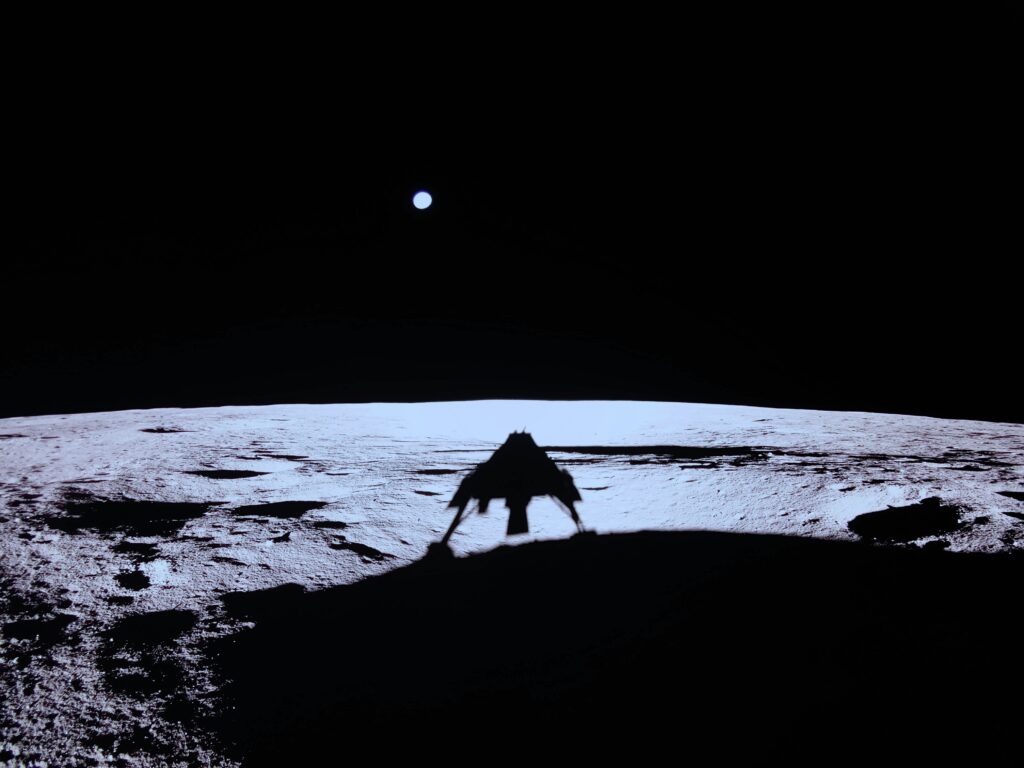
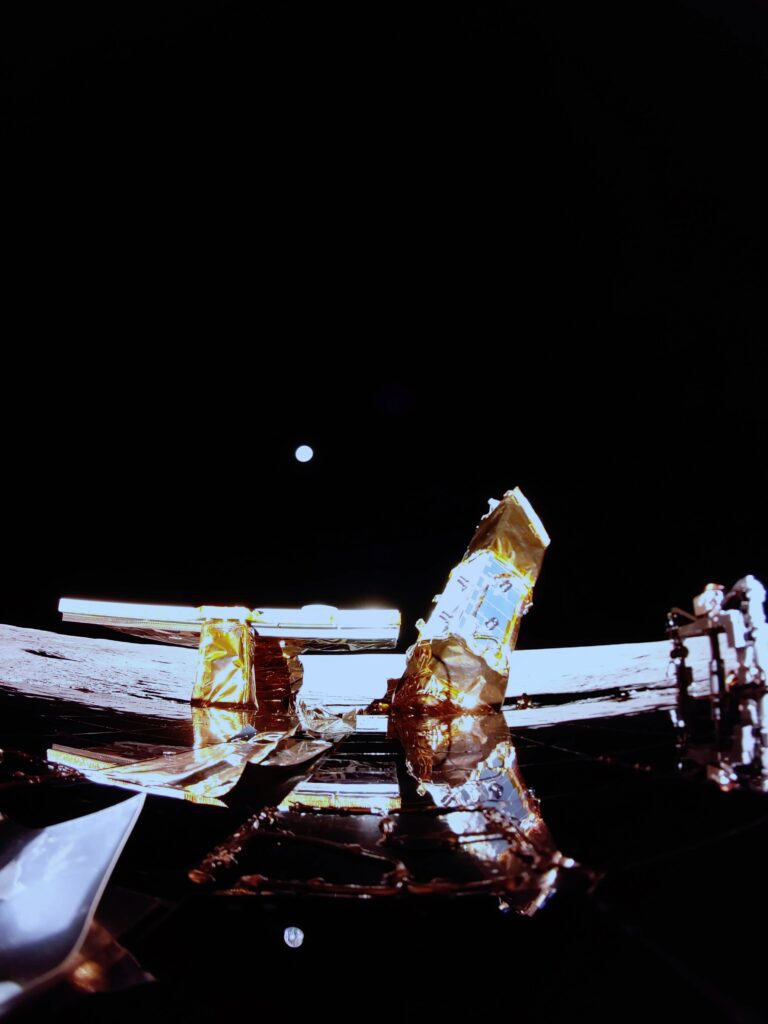
March 2, 2025, 3:08 am CST: First Image on the Moon
Blue Ghost just captured its first Moon image after successfully landing! The image shows the Moon’s surface and a top-down view of the lander’s RCS thrusters (center) with a sun glare on the right side. Credit: Firefly Aerospace
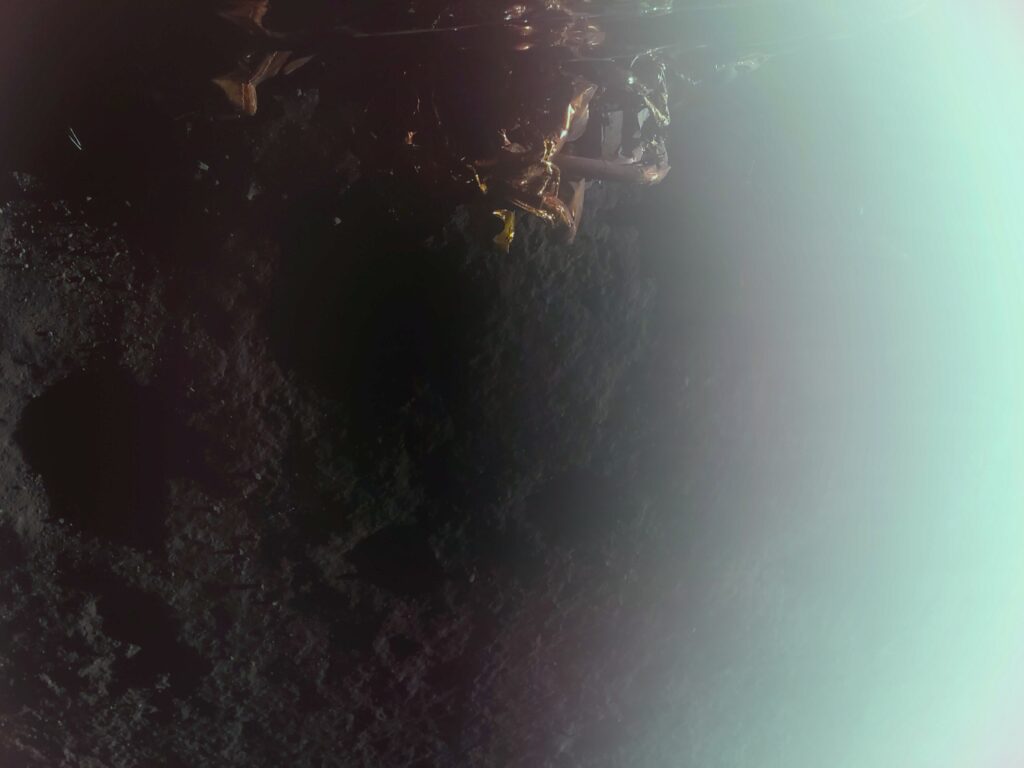
March 2, 2025, 2:34 am CST: Successful Touchdown Confirmed
We have confirmation Blue Ghost stuck the landing! Firefly just became the first commercial company in history to achieve a fully successful Moon landing. This small step on the Moon represents a giant leap in commercial exploration. Congratulations to the entire Firefly team, our mission partners, and our NASA customers for this incredible feat that paves the way for future missions to the Moon and Mars. Standby for the first image, expected in the next 30 minutes!
March 2, 2025, 2:32 am CST: Powered Descent Initiation Complete
Blue Ghost main engine has shut off after a successful Powered Descent Initiation. Now less than 2 minutes from touchdown, our Spectre RCS thrusters will perform the final descent, pulsing as needed to reduce orbital velocity to 1 meter per second before touchdown. Blue Ghost’s vision navigation system is concurrently tracking craters, slopes, and rocks to select a hazard free parking spot within our landing zone.
March 2, 2025, 2:22 am CST: Powered Descent Initiation Begins
Powered Descent Initiation has begun! During this 9-minute braking burn with all engines, Blue Ghost is fully autonomous, using D’Souza Guidance – a model similar to the guidance used during the Apollo Moon missions – to position itself above the target landing site and pitch over from a horizontal to a vertical orientation.
March 2, 2025, 2:19 am CST: GO for Powered Descent Initiation
Firefly is GO for Powered Descent Initiation in just under 5 minutes! This critical 9-minute braking burn with all engines will reduce Blue Ghost’s orbital velocity from about 1,700 to 40 meters per second. At this point forward, Blue Ghost will take the wheel until we land – we trust the lander to do what it’s designed to do!
March 2, 2025, 1:49 am CST: Descent Orbit Insertion Confirmation
Blue Ghost is officially on a descent trajectory towards the Moon’s Mare Crisium! Our Descent Orbit Insertion was successful, and Blue Ghost will now coast with all engines off for the next ~30 minutes until we descend to about 20 km above the surface and begin our Powered Descent Initiation with a braking burn. We’ll use the vision-based terrain navigation system along the way to determine Blue Ghost’s position. Follow along with our livestream: Firefly’s Blue Ghost Mission 1 Lunar Landing.
LUNAR ORBIT OPERATIONS
March 1, 2025: Descent Orbit Insertion Command Sent
Firefly’s flight controllers just sent the command for Descent Orbit Insertion (DOI) 9 hours ahead of time since this burn is performed on the far side of the Moon during a planned comms blackout. We expect to regain signal about 20 minutes after the burn to ensure Blue Ghost is on the right course. If not, the team can opt to orbit the Moon again and attempt another DOI.
February 27, 2025: Week 6 Mission Operations Update
Blue Ghost is less than three days from landing on the Moon and has already traveled millions of miles and downlinked more than 27 GB of data. As we get closer to our final destination, hear from the Firefly team on how we’re preparing for descent and what’s next after we land.
February 26, 2025: Moon Footage in Low Lunar Orbit
Firefly’s Blue Ghost lander captured more incredible footage of the Moon during its third lunar orbit maneuver on February 24 that inserted the spacecraft in a near-circular low lunar orbit. The video below, sped up by 10X, was taken about 100 km above the lunar surface, showing the far side of the Moon and a top-down view of Blue Ghost’s RCS thrusters (center) and radiator panels on each side. The radiator panels are moving nominally to protect Blue Ghost’s subsystems from extreme temperatures.
February 24, 2025: Third Lunar Orbit Maneuver Complete
Blue Ghost’s third and final lunar orbit maneuver is complete! Early this morning, the Firefly team performed a 16-second burn with our RCS thrusters to enter a near-circular low lunar orbit. Up next, we’ll perform a 19-second Descent Orbit Insertion at our 100-km perilune to begin our descent to Blue Ghost’s final destination, Mare Crisium, on March 2.
Footage above showing the Earth rising and setting behind the Moon was captured by Firefly’s Blue Ghost lunar lander shortly after our second lunar orbit maneuver on February 18. Blue Ghost’s solar panel, X-band antenna (left), and LEXI payload (right) on the top deck is also shown. Credit: Firefly Aerospace
February 21, 2025: LuGRE and LEXI Payload Science Operations
All 10 NASA payloads remain healthy as Blue Ghost approaches its final destination and continues to support science operations along the way. The LuGRE payload for example – developed in partnership by the Italian Space Agency and NASA Goddard Space Flight Center, acquired and tracked Global Navigation Satellite System signals for the first time in lunar orbit – a new record! The LEXI telescope, developed NASA, Boston University, and Johns Hopkins University, has also operated for several hours every day, conducting checkouts and initial commissioning in preparation for collecting images from the lunar surface. Learn more on NASA’s Artemis blog.
February 21, 2025: Preparation for Final Lunar Orbit Maneuver
The beauty of taking the scenic route is we have time to adjust our maneuvers based on real flight data along the way! For our third and final lunar orbit maneuver scheduled early Monday morning, Firefly will perform a 16-second burn that inserts Blue Ghost into a near-circular low lunar orbit with a 100-km perilune (the closest point to the Moon’s surface). This will put us in prime position to perform a Descent Orbit Insertion as planned on March 2. Stay tuned for more.
February 20, 2025: Week 5 Mission Operations Update
10 days left in Firefly’s lunar roadtrip and Blue Ghost has traveled 2.2 million miles so far and downlinked 18.7 GB of data! The Firefly team has already accomplished so many milestones, but there are still more to come. Catch our week 5 update on what’s next as we prepare to land on the Moon on March 2.
February 18, 2025: Second Lunar Orbit Maneuver Complete
The Firefly team completed another lunar orbit maneuver with a 3 minute, 18 second burn at 3:09 am this morning. This maneuver moved the lander from a high elliptical orbit to a much lower elliptical orbit around the Moon. Shortly after the burn, Blue Ghost captured incredible footage of the Moon’s far side, about 120 km above the surface.
In this orbit, the team will experience planned rolling comms blackouts as Blue Ghost goes around the far side of the Moon. When on the near side, the team will continue to downlink data and finalize the plan for our next maneuver that will get Blue Ghost even closer to the lunar surface and keep us right on track for landing on March 2.
February 14, 2025: First Moon Images in Lunar Orbit
During its Lunar Orbit Insertion burn, Blue Ghost captured our first close-up shots of the Moon. Blue Ghost will now spend 16 days in lunar orbit and perform additional maneuvers to take the lander from an elliptical orbit to a circular orbit around the Moon.
The images taken during Blue Ghost’s Lunar Orbit Insertion were stitched together in a timelapse video. Credit: Firefly Aerospace
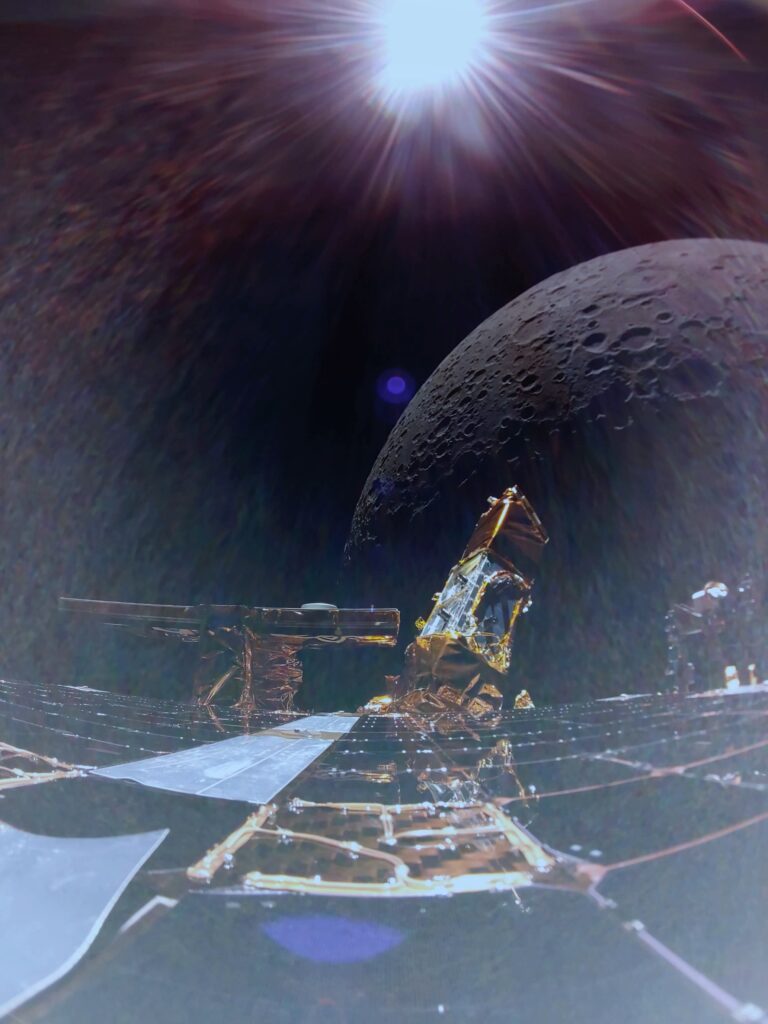
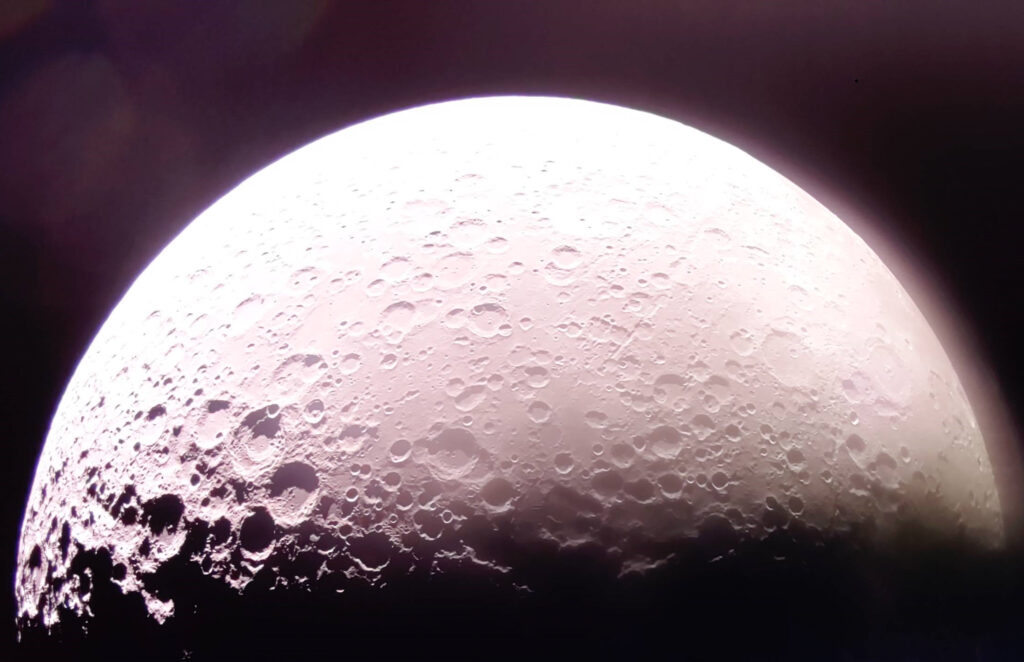
February 13, 2025: Lunar Orbit Insertion
The Firefly team nailed our most challenging burn to date! Starting at 7:51 p.m. CST on February 13, the team completed a 4 minute, 15 second Lunar Orbit Insertion burn with Blue Ghost’s RCS thrusters and main engine to enter an elliptical orbit around the Moon. Over the next 16 days, we’ll conduct additional maneuvers to circularize our orbit and get closer to the lunar surface.
LUNAR TRANSIT OPERATIONS
February 13, 2025: Week 4 Mission Operations Update
Four weeks into Firefly’s mission, the team walks through our latest burns that propelled us beyond Earth’s orbit toward the Moon. Get a behind-the-scenes look at Blue Ghost mission ops during a burn and discover the unique relationship between Flight Directors and Flight Controllers.
February 12, 2025: New Earth + Moon Images
Goodbye Earth, hello Moon. Following Trans Lunar Injection, Blue Ghost captured two new incredible shots – one of Earth with the Moon in the distance and one of Earth reflecting off our solar panel with the Moon on the horizon. Now four weeks into the mission, Blue Ghost has downlinked more than 15 GB of data, including NASA science data, from record-breaking GNSS signals to magnetic field measurements, that is already unlocking insights for the future of space exploration.
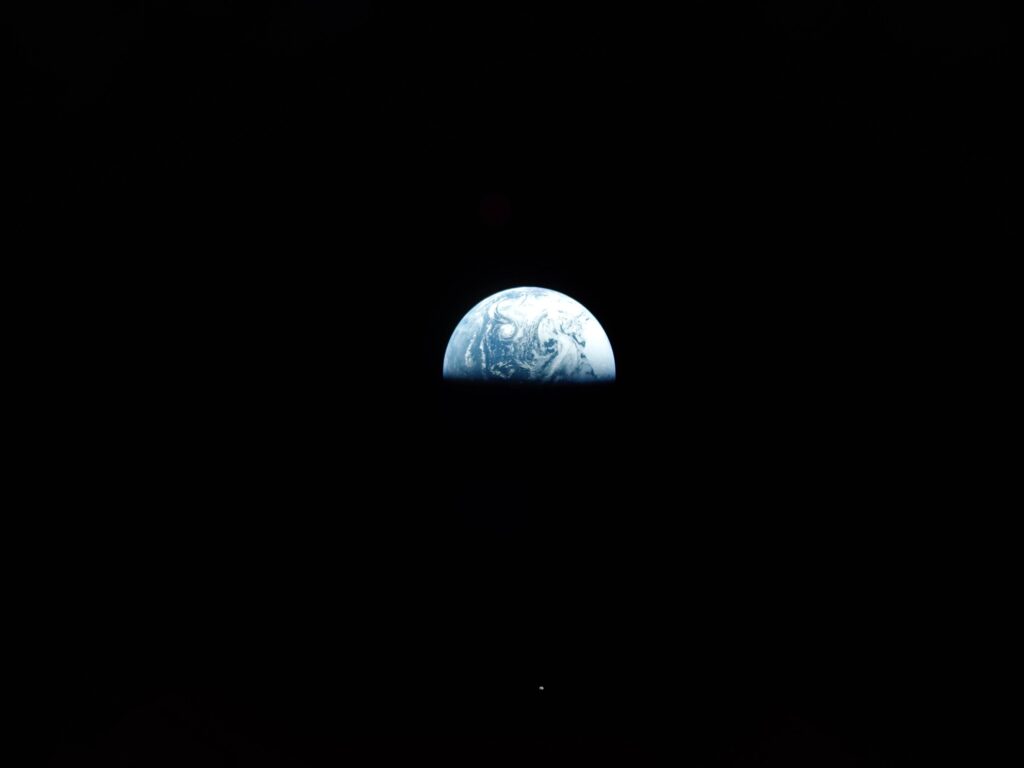
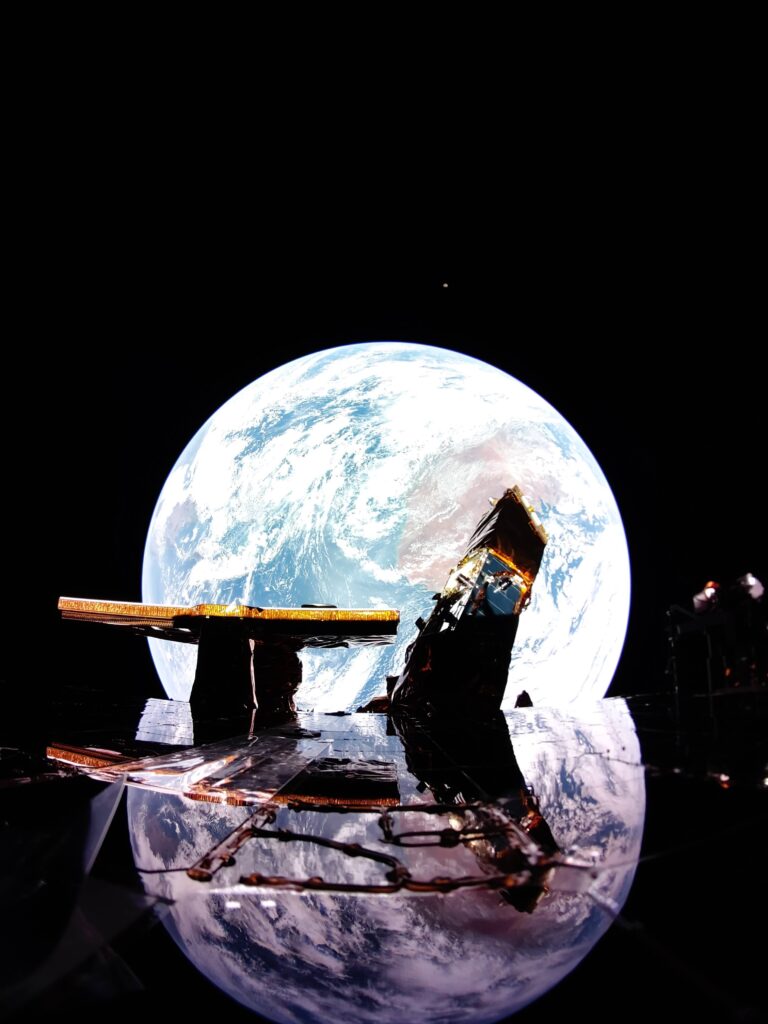
February 11, 2025: Trajectory Correction Maneuver 2 Update
The Firefly team confirmed Blue Ghost’s first trajectory correction maneuver was performed with such accuracy we are skipping the next one. With Earth in the rearview mirror, we’re on cruise control until we reach the Moon’s orbit and perform a Lunar Orbit Insertion in just a couple days.
February 10, 2025: RadPC, LMS, and LPV Payload Operations
Blue Ghost has already downlinked nearly 13 GB of data during our journey to the Moon, including some incredible payload science for NASA. The latest payload successes include radiation tolerant computing through the Van Allen Belts with Montana State University’s RadPC, measuring changes in the magnetic field with the Southwest Research Institute’s Lunar Magnetotelluric Sounder (LMS), and ongoing health checks for Honeybee Robotics’ Lunar PlanetVac (LPV).
Since launching on January 15, Blue Ghost has performed dozens of health tests, and all 10 NASA payloads onboard remain healthy and ready for surface operations on the Moon. Learn more on the NASA Artemis blog.
February 9, 2025: Trajectory Correction Maneuver Complete
Following Trans Lunar Injection, Blue Ghost successfully performed a Trajectory Correction Maneuver to help keep us on course during our transit to the Moon.
February 8, 2025: Trans Lunar Injection Complete
Blue Ghost successfully performed a Trans Lunar Injection burn to escape Earth’s gravitational pull and begin a 4-day transit to the Moon’s orbit. We’ll then spend approximately 16 days in lunar orbit before we begin Blue Ghost’s descent. This gives Firefly plenty of time to calibrate our navigation system and continue payload science operations for NASA.
EARTH ORBIT OPERATIONS
February 7, 2025: Blue Ghost Captures Australia
Blue Ghost captures another Earth image – this time showing Australia – during our final days in Earth orbit.
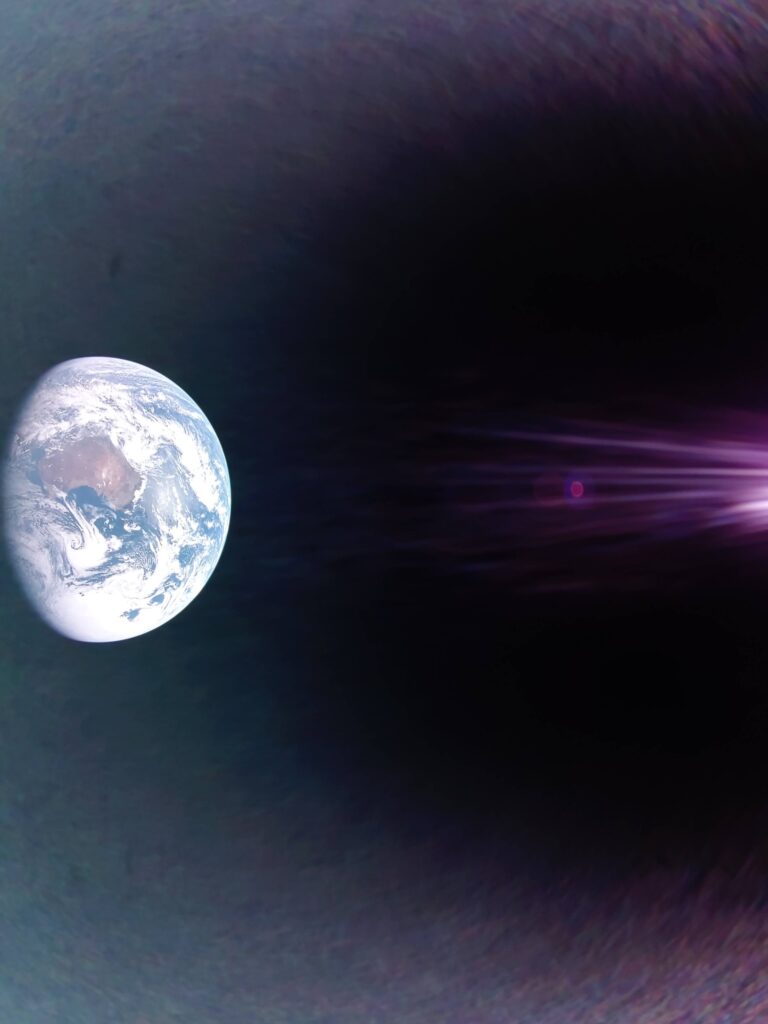
February 6, 2025: Week 3 Mission Operations Update
Three weeks into Firefly’s mission, and Blue Ghost has already downlinked more than 11 GB of data. In our week three recap, the Firefly team gives an overview of our upcoming Trans Lunar Injection burn and shares how we strive to encourage the next generation to dream big!
February 3, 2025: Blue Ghost Captures Earth Selfie
T-5 days until Blue Ghost says goodbye to Earth! With the accuracy Firefly achieved on our first two engine burns, we were able to skip the third Earth orbit maneuver. Blue Ghost is already in a good position to perform our trans-lunar injection in just under a week. The Firefly team continues to capture some incredible shots of our home planet along the way.

January 31, 2025: Blue Ghost Captures Earth Eclipsing the Moon
Blue Ghost captured an amazing view of Earth eclipsing the Moon as the lander continues to travel on orbit.
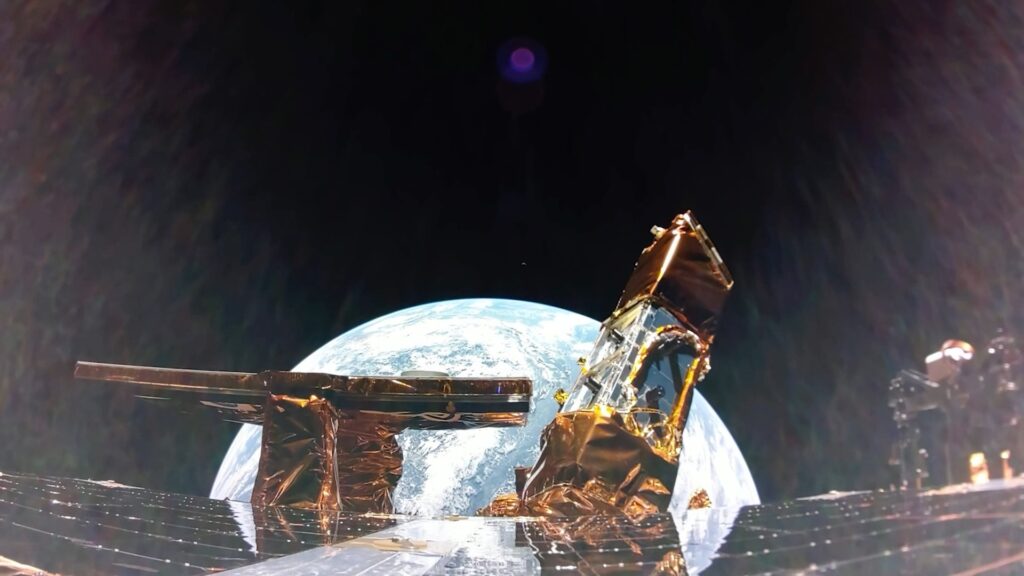
January 30, 2025: SCALPSS Payload Operations
The Firefly team completed test runs of the SCALPSS payload onboard Blue Ghost. Developed by the NASA Langley Research Center, SCALPSS will observe the effects of engine plumes on lunar regolith when Blue Ghost touches down on the Moon. The test images captured during transit demonstrate the hardware is functioning well and is capable of collecting images of plume-surface interactions upon lunar touchdown. Learn more on the NASA Artemis blog.
January 30, 2025: Week 2 Mission Operations Update
Two weeks into Firefly’s mission, and Blue Ghost has already clocked 715,000 miles and downlinked more than 7 GB of data. In our week two recap, the Firefly mission operations team provides an overview of our orbital mechanics and thermal dynamics and explains why Blue Ghost is taking a scenic route to the Moon.
January 28, 2025: LEXI Payload Calibration
The Firefly team began calibrating the LEXI X-ray imager to maximize its performance levels and prepare for operations on the lunar surface. Developed by Boston University, NASA, and John Hopkins, LEXI will be calibrated daily until we land on the Moon. The payload will then capture a series of X-ray images to study the interaction of solar wind and the Earth’s magnetic field that drives geomagnetic disturbances and storms on our home planet.
January 27, 2025: First Moon Image
While in Earth orbit, Firefly’s Blue Ghost lunar lander captured our first images of the Moon.
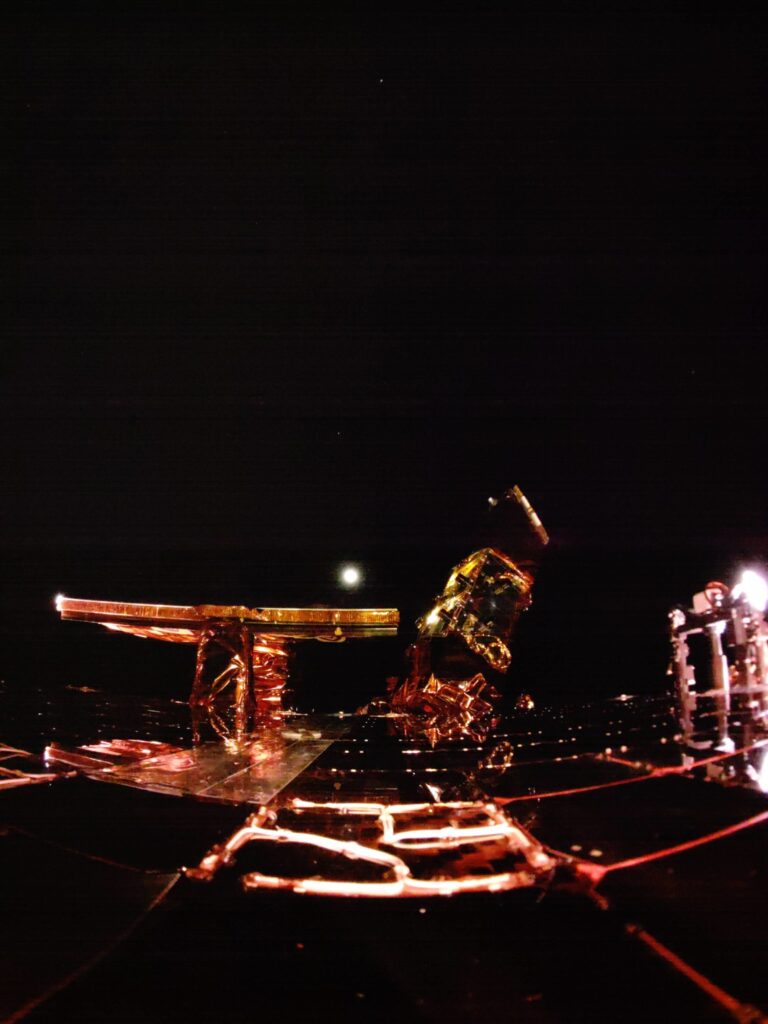

January 24, 2025: Second Engine Burn
Firefly captured the beauty of our home planet during another Earth orbit burn. This second engine burn (and first critical burn) adjusted Blue Ghost’s apogee (the furthest point from Earth) using our Spectre RCS thrusters. With just over two weeks left in Earth orbit before our Trans Lunar Injection, the Firefly team will continue operating our NASA payloads onboard and capturing science data along the way.

January 23, 2025: Week 1 Mission Operations Update
Firefly’s Blue Ghost lander is one week into our road trip to the Moon! Hear directly from the Firefly team on the milestones we’ve achieved this past week.
January 21, 2025: New LuGRE Payload Milestone
Jointly developed by NASA and the Italian Space Agency, the Lunar GNSS Receiver Experiment (LuGRE) payload acquired signal from the Earth-based Global Navigation Satellite System (GNSS) at a record-breaking distance of 205,674 miles. This step towards establishing a navigation solution to the Moon marks another successful milestone for Firefly’s payload partners traveling aboard Blue Ghost. Learn more about the achievement on NASA’s Artemis blog.
January 21, 2025: Earth Eclipse Captured
Blue Ghost captured Earth eclipsing the Sun from Blue Ghost’s top deck. This timelapse is another incredible postcard moment on our trip to the Moon.
January 20, 2025: Ongoing Data Downlinks
Firefly is five days into the Ghost Riders in the Sky mission, and Blue Ghost has traveled 22,000 miles while downlinking 1.4 GB of data thus far. While there’s still a long road ahead, the team has already accomplished several critical milestones on the way to the Moon.
January 18, 2025: First Engine Burn
Big win for the Ghost Riders! The Firefly team successfully completed Blue Ghost’s first burn with our RCS thrusters and main engine, hitting within 2 mm/s of our target delta V on the first try. This burn increased the lander’s perigee (the closest point to Earth) and gets us ready for our next critical maneuver. Take a look at these engines firing with invisible plumes in the vacuum of space.
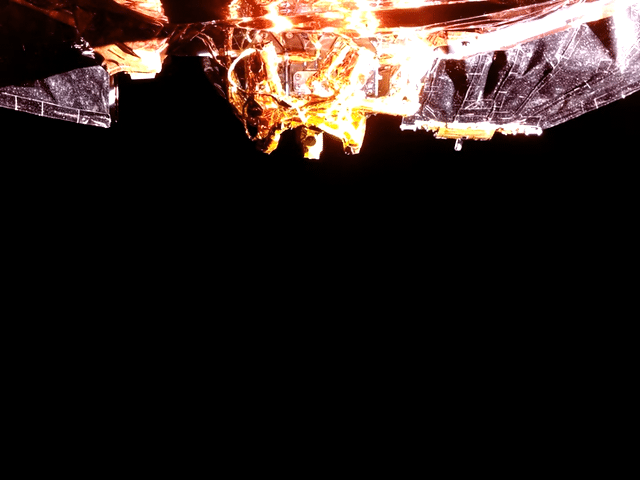
January 17, 2025: Bi-Propellant Priming Complete
Blue Ghost’s fluid and propulsion systems are now primed up. This bi-propellant priming process distributes our fuel and oxidizer to the engines, getting them ready for our first burn in a couple days. Although not vital to the mission, this first burn will help calibrate Blue Ghost’s propulsion system ahead of a critical burn next week that will raise our Earth orbit apogee and get us closer to the Moon.
January 16, 2025: LuGRE Payload Science Operations
All NASA payloads remain healthy. Six NASA payloads onboard Blue Ghost, including RadPC, SCALPSS, LPV, LISTER, LuGRE, and EDS are already sending initial data back to Earth. LuGRE science operations have also begun. Developed by the Italian Space Agency, LuGRE is tracking signals from GPS and Galileo satellites during our Earth to Moon transit to test signal acquisition and usage along the way.
January 15, 2025: First On-Orbit Image
Firefly’s Blue Ghost captured its first image from space! The top deck of the lander is visible with the X-band antenna and NASA’s LEXI payload.
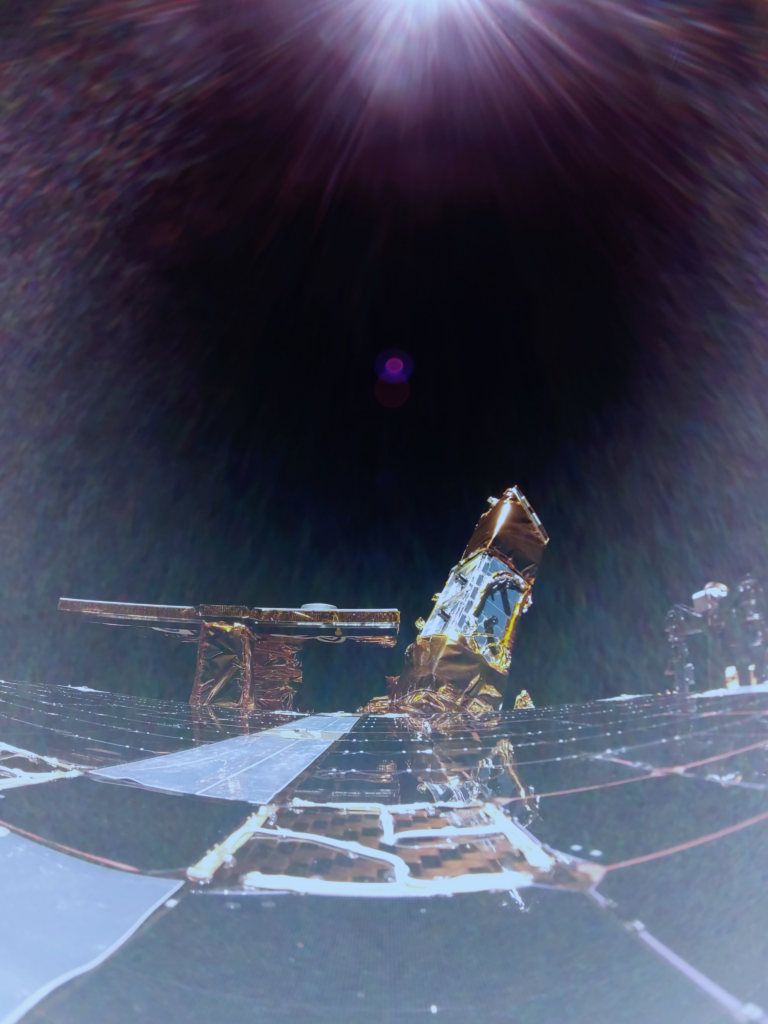
January 15, 2025: On-Orbit Payload Science Begins
The Firefly team completed initial NASA payload checkouts and powered on Montana State University’s RadPC to begin measuring the radiation and fault tolerant computing system. This is the first of many payload data sets Blue Ghost will capture on Firefly’s journey to the Moon.
ON-ORBIT COMMISSIONING
January 15, 2025: On-Orbit Spacecraft Commissioning Complete
On-orbit spacecraft commissioning was completed by 5:30 a.m. EST, which included verifying attitude determination and control capabilities, increasing the data transfer rate, establishing a power-positive attitude, and completing initial lander health checks. Read the press release for more details.
January 15, 2025: Blue Ghost Signal Acquistion
Firefly’s Mission Operations Center in Cedar Park, Texas, acquired signal from the Blue Ghost lunar lander at 2:26 a.m. EST. The team will now begin initial Blue Ghost health checks as part of on-orbit commissioning.
LAUNCH OPERATIONS
January 15, 2025: Launch Vehicle Separation
Blue Ghost was deployed in a highly elliptical Earth orbit at 2:17 a.m. EST. The Firefly team expects to acquire signal to the lander within the next 30 minutes.

January 15, 2025: Liftoff
SpaceX’s Falcon 9 rocket lifted off from the Kennedy Space Center launch complex 39A at 1:11 am EST, and Blue Ghost is on its way to orbit!
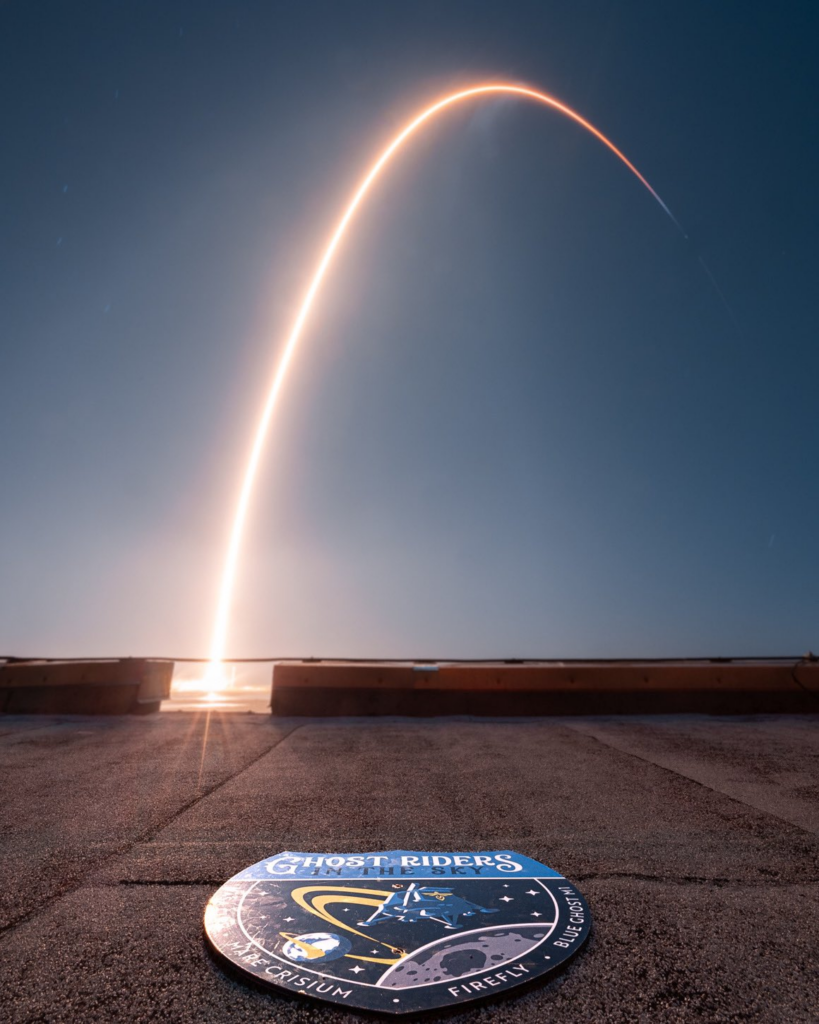
PRE-LAUNCH OPERATIONS
January 14, 2025: Rocket Mating & Rollout
The encapsulated fairing has been mated to SpaceX’s Falcon 9 rocket and transported to the launch pad ahead of liftoff scheduled for 1:11 am EST on January 15.
January 10, 2025: Fairing Encapsulation
Blue Ghost was safely encapsulated in the Falcon 9 fairing.
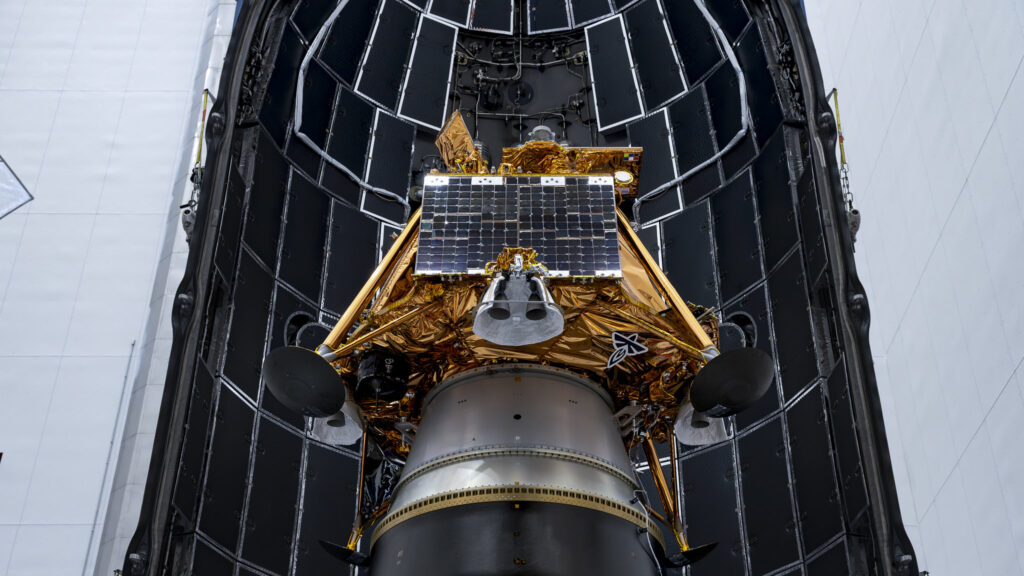
January 9, 2025: Falcon 9 Integration
All Remove Before Flight tags are off Blue Ghost, and the lander is now securely integrated on the SpaceX Falcon 9 payload attach fitting.
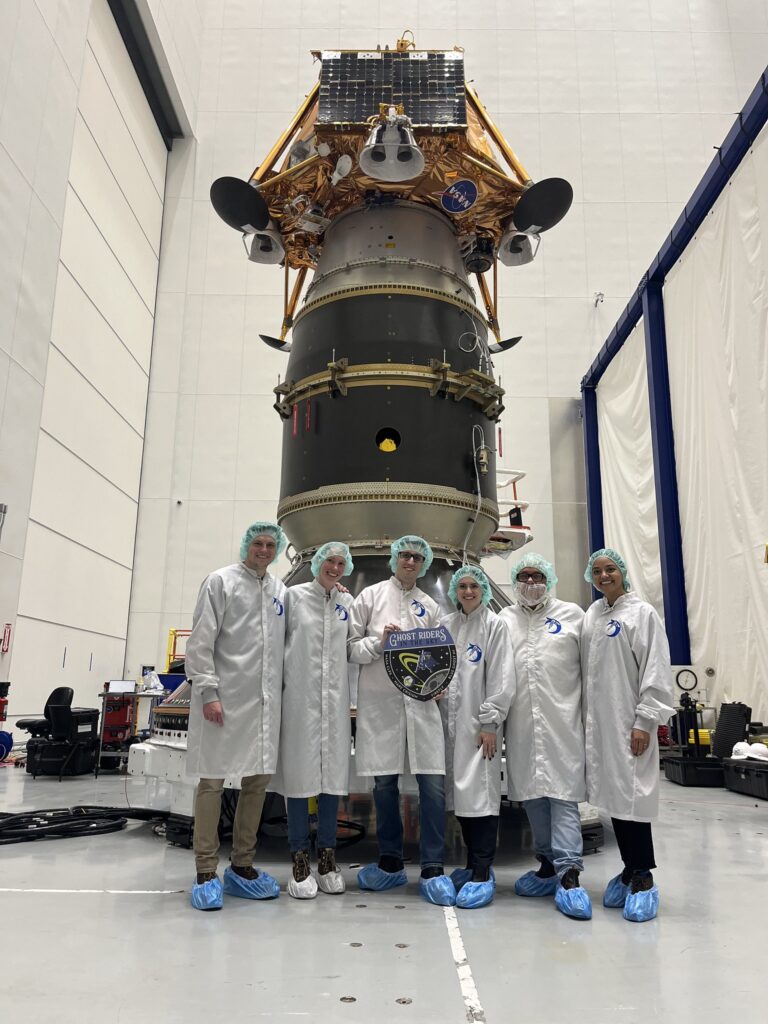
January 8, 2025: Blue Ghost Fueling Complete
Firefly’s Blue Ghost lunar lander was loaded up with an MMH hypergolic propellant and MON-3 oxidizer to power the thrusters and main engine during transit from Earth to Moon.
December 23, 2024: Blue Ghost Battery Charging Complete
All four batteries on Blue Ghost are now fully charged. Firefly will utilize these batteries as needed throughout the mission when sunlight is limited, such as in the lunar morning and lunar night.
December 16, 2024: Blue Ghost Arrives at KSC
Firefly’s Blue Ghost lunar lander arrived at the Kennedy Space Center (KSC) in Florida on December 16. The Firefly team is now working through the pre-launch operations, including final inspections, functional checkouts, battery charging, propellant loading, and integration on the SpaceX Falcon 9 rocket.

